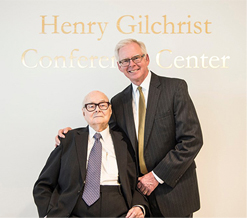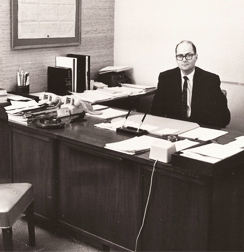© 2017 The Texas Lawbook.
By Natalie Posgate
(May 8) – Henry Gilchrist, the legendary transactional lawyer who represented Clint Murchison and the Dallas Cowboys and helped raise the profile of the legal market in Dallas, passed away early Saturday morning. He was 92.
Gilchrist had remained in practice until very nearly the end of his life, serving clients for 67 years. He retired from Hunton & Williams in September.
Named by Texas Lawbook a Lion of the Texas Bar, Gilchrist was the fifth lawyer to join Jenkens & Bowen, the prominent Dallas firm that became to be known as Jenkens & Gilchrist. He served as the firm’s managing partner for about 25 years. Gilchrist joined Hunton & Williams in 2007 after the demise of his namesake firm.
Former colleagues remember Gilchrist as someone who treated everyone with respect, remained humble, mentored younger lawyers and valued the quality of the person more than the quality of the practice.
“I was a summer associate when Henry was the managing partner at Jenkens & Gilchrist, and he treated me the same then as when I was the chairman of Jenkens & Gilchrist in 2007,” said Pat Mitchell, who is now the managing partner of Hunton & Williams’ Dallas office.

“The other thing I found remarkable was when he was still a very successful corporate lawyer and managing partner – and a named partner – he stepped aside of management because he felt it was more important for the next generation of partners to manage the law firm,” Mitchell added. “Henry did not cling to the reins of power because he felt it was better for their situation to allow [the firm] to evolve. You don’t see that as much anymore.”
Gilchrist was also a World War II veteran and a devoted citizen to the Dallas community, where he was involved in various civic and charitable organizations.
Though he quickly rose to prominence in the legal community, Gilchrist’s legal career wasn’t always clear-cut.
Born in 1924, Gilchrist grew up in College Station, where his father, Gibb Gilchrist, served as the president of A & M College and the first chancellor of the Texas A & M System.
Gilchrist was halfway through his senior year of high school when the Japanese attacked Pearl Harbor on Dec. 7, 1941. The draft was inevitable, but did not immediately affect Gilchrist, who began pursuing a bachelor’s degree in civil engineering after he graduated the next year.
Gilchrist was originally able to begin college due to a program called the Army Specialized Training Program, which was designed to allow college students to finish their education before entering active service in the Army.
The ASTR program, however, was cut short due to the escalation of the war, so Gilchrist instead found himself in Panama with the Coast Artillery to join the group protecting the Panama Canal from attack.
He stayed there until the war ended. When he returned to Texas, Gilchrist went back to A&M and completed his civil engineering degree in January 1948.
He enrolled in the University of Texas School of Law a week after he graduated.
While at UT Law, Gilchrist served as the senior note editor of the Texas Law Review. He was also Prof. M. K. Woodward’s Quizmaster, was inducted into the Chancellors honor society, belonged to the Phi Delta Phi legal fraternity, and was elected to the Order of the Coif upon graduation in August 1950.
Though he later became one of the most well-known lawyers in Dallas, Gilchrist’s legal career started out five-and-a-half hours away in the Panhandle town of Pampa.
In Pampa, he worked for a distant relative at the firm Douglass & McGuire, but during that time, he and his wife, Patricia, still called College Station home.
Trips back to college station involved driving 10 hours with a bucket of ice between them since their car did not have air conditioning.
“It kind of made sense to try to [move] back,” Gilchrist told The Texas Lawbook in a 2015 interview.
Gilchrist started interviewing for jobs in Dallas, where he met with family friend Gerald C. Mann, who was the former Texas attorney general. Mann’s nickname was “Little Red Arrow” from his days as a star SMU Mustangs football player. Most importantly, he had a connection to the prominent Murchison family’s law firm, and recommended Gilchrist talk to them.
Gilchrist did and in 1952 became the fifth lawyer at Jenkens & Bowen, which later became the successful Jenkens & Gilchrist law firm. He spent decades at the firm representing oil tycoon Clint Murchison and his two sons in deals that attracted national attention, such as the purchase and establishment of the Dallas Cowboys.
Gilchrist advised the Murchisons on many other high-dollar transactions, including the development of the Denver Club Building; the merger between TCO Industries, Inc. and Holiday Inns; the purchase of St. Louis Car Company; the hiring of the Dallas Cowboys Cheerleaders; the contract drafting for Cowboys’ general manager Tex Schramm and Cowboys’ coach Tom Landry; and the development of the Texas Stadium.

“It is both interesting and frightening how small things can affect the course of one’s life,” Gilchrist wrote in a book, titled The First Fifty Years at Jenkens & Gilchrist. “A false move to Pampa and a courtesy call to a family friend certainly impacted my life.”
Former Jenkens & Gilchrist colleagues say Gilchrist’s work brought prominence to Dallas at a time Americans’ memories dwelled on the JFK shooting – which Gilchrist said he witnessed from his office window at 1201 Main St.
“He had a huge impact on increasing the profile of Dallas law firms on a national scale in the 1970s and 1980s,” Austin attorney Bill Parrish told The Texas Lawbook in a 2014 interview when Gilchrist turned 90. “He was doing as sophisticated work as anybody in the country at a time when people didn’t recognize Texas firms – especially Dallas firms – for that quality of sophisticated work.”
Because the business the Murchison family was involved in entailed so many high-profile corporate transactions, the work Gilchrist and his team did “helped establish Dallas as a center for business activity,” Mitchell said.
“Henry and his team were involved in virtually everything, since they worked right below the floor of the Murchison’s office in their prior location,” Mitchell added. “They were rubbing elbows with some more notable New York Wall Street firms and holding their own, and it set them apart because of the fact that they could negotiate with these law firms.”
Jenkens & Gilchrist ultimately fell apart due to tax issues the firm’s Chicago office ran into with the Internal Revenue Service. When the firm was forced to shut its doors in 2007, Gilchrist was among the nearly 100 attorneys from Jenkens & Gilchrist’s Dallas, Houston and Austin offices who joined Hunton & Williams.
Parrish said because of the culture Gilchrist created at Jenkens & Gilchrist, the transition went as smoothly as it possibly could have while maintaining the firm’s core values of everyone looking out for each other. This meant the firm found “a landing place for every lawyer, secretary and staff member” to its best ability, Parrish said.
“We were different from any firm I’m aware of that has been through that process,” said Parrish, who was at Jenkens & Gilchrist for about 30 years and served part of his time there as the firm’s Austin managing partner. “We never filed for bankruptcy or had a bad fight among the lawyers.”
When asked about his favorite memory of Gilchrist, Mitchell recalled back to when he was a young partner at Jenkens & Gilchrist and “just getting involved in firm management.” He and others from the management team had a meeting with Gilchrist to discuss the prospect of merging with another large firm. At the meeting, they told Gilchrist of the expense savings of combining offices, where the other firm’s offices where and how the other firm could expand Jenkens & Gilchrist’s footprint.

“Henry looked up at the three of us and said, ‘I haven’t heard you say anything about the quality of their people and their willingness to serve our clients. We’re a law firm and we must grow in a way that serves our clients, and we must focus on the quality of the people that we’re associated with, whether it’s partners or associates, and that has to be the focus on any transaction, not these other accounting items.’
“That had a profound impression on me,” Mitchell said. “We do get focused on the economic side of law firms because unfortunately it’s important, but it can’t be the guiding principle.”
Gilchrist is survived by his two children, Tom Gilchrist and Terri Gilchrist Plauche. His wife, Patricia, died in 2010.
A memorial service is scheduled on Wednesday, May 24, at 4:00 p.m. at Highland Park United Methodist Church in Dallas.
© 2017 The Texas Lawbook. Content of The Texas Lawbook is controlled and protected by specific licensing agreements with our subscribers and under federal copyright laws. Any distribution of this content without the consent of The Texas Lawbook is prohibited.
If you see any inaccuracy in any article in The Texas Lawbook, please contact us. Our goal is content that is 100% true and accurate. Thank you.
